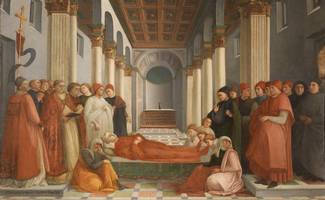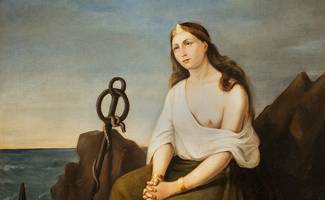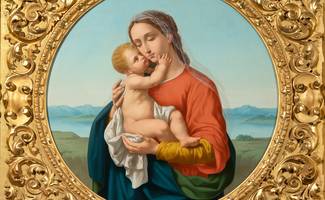Room 5
The artworks in this room are an example of the 19th century painting in Prato.
Antonio Marini is considered one of the leading representative of Purism, a movement he cultivated by studying the Medieval and Renaissance masters.
Antonio Marini, born in Prato, studied at the Municipal School of Drawing with Luigi Nuti and then at the Accademia delle Belle Arti in Florence. He devoted his life both to painting and to restoration; especially, he worked extensively in Prato’s Cathedral restoring the frescoes in the Chapel of the Sacra Cintola in 1834 and those by Filippo Lippi in 1837.
The Palazzo Pretorio Museum hosts his Madonna del Bacio, donated to the Municipality by his wife Giulia Nuti in 1867: that canvas is the emblem of the culture in vogue at that period in the literary circles, encouraging the emulation of Renaissance painters from Tuscany and Umbria. The allegorical painting here on display presents, instead, a subject referring to the first great disenchantment of the Italian Risorgimento: a melancholic woman is depicted in a gloomy tone, representing a blessed Italy with no hope. Stylistically, it recalls new artistic expressions from his time, such as the symbolic aim of some female figures painted by Francesco Hayez.
In 1932 one room of this building was dedicated to Antonio Marini, with the purpose to exhibit his paintings, drawings, cartoons and sketches acquired by the Municipality – among these were, the aforementioned Madonna del Bacio and the canvas with St. Philip Neri and St. Catherine de’ Ricci (still in this palace) – in addition to other artworks by different artists from the 19th century, like Pietro Pezzati’s Madonna with the Child.
Image gallery



Last update: 28 october 2025, 10:43